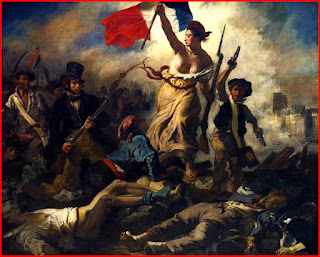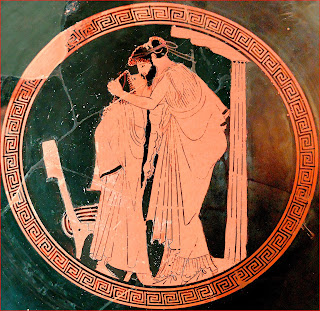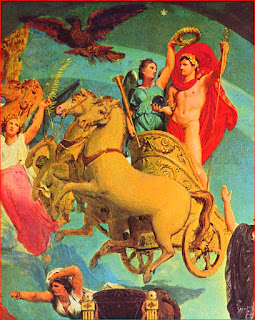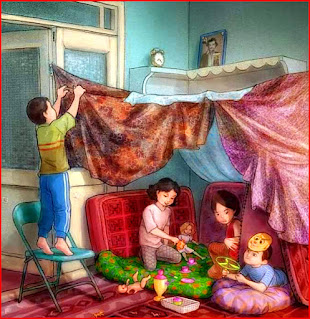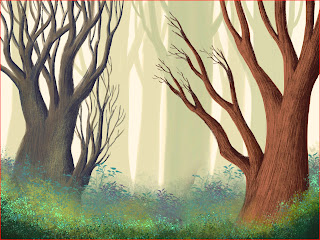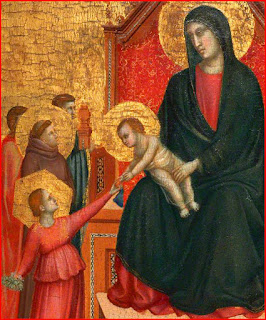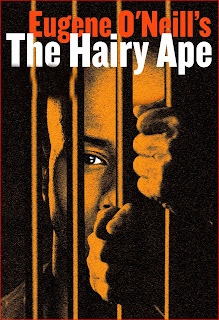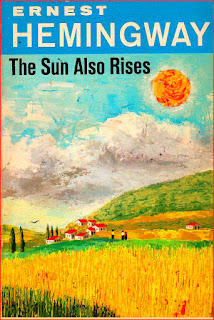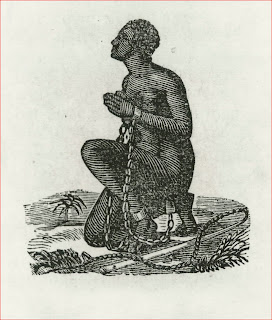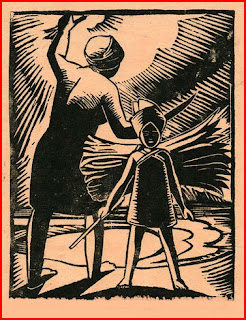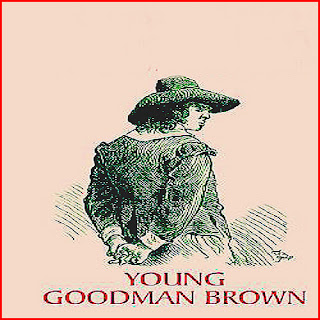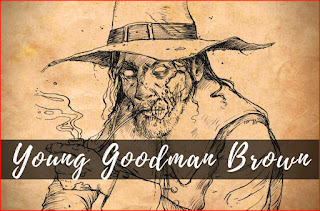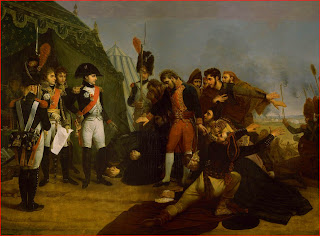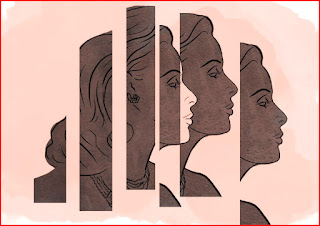Saturday 30 December 2017
Saturday 4 November 2017
Comment on Male-Female Relationships in Sylvia Plath’s Poetry?
Male-Female Relationships in Sylvia Plath’s Poetry
There are two kinds of male-female relationships in Sylvia Plath’s poetry: those between fathers and daughters and between husbands and wives. Neither relationship seems to be happy. In ‘Lesbos’ the husbands are impotent, useless, deserving of scornful dismissal. They could be said of the potential husband s in ‘The Applicant’. But at least these men are not physically threatening, as the black demi-devil husbands in ‘Daddy’ most definitely is. Here the husband is sadistic torturer. The silent, silver suited husband who brings the sinister gift in ‘A Birthday Present’ is alarming too. He torments his wife in different, more subtle ways. Overall, heterosexual love relationships are problematic in Sylvia Plath’s poems. Even when she writes excitedly about being pursued by a lover, there is a strong current of violence running through the poem, ‘Pursuit’, a suggestion that the female is the victim, the bait. She will be eaten up worn out, cast aside.
Discuss the Theme of Motherhood in the Poetry of Sylvia Plath with Special Reference to ‘Morning Song’.
Theme of Motherhood in the Poetry of Sylvia Plath
A number of poems of Sylvia Plath deal with mothering. Sylvia Plath is not sentimental about motherhood. It is not an unambiguously blessed state in her work. The most obvious positive statement about children is ‘you’re’, which can be read as a celebration of pregnancy. Here Sylvia Plath captures the affection and eagerness of the expectant mother. ‘You’re’ and ‘Morning Song’ suggest that Sylvia Plath saw babies as unique, individual personalities; the child is never simply an extension of the mother in her poetry. She observes babies closely, showing us the wonder of new life through her use of unusual and unexpected metaphors and similes to describe infants.
‘Morning
Song’ was written by Sylvia Plath after the birth of her first child, ‘Frieda’.
She intended that it should be the first poem published in the ‘Ariel’
collection. The tone is different from the cheerful mood of ‘you’re’, although
the poet continues to explore feelings and ideas about motherhood that are
familiar from the earlier poem.
Critically Comment on Yeats’s Use of Symbol.
Yeats’s Use of Symbol
Yeats’ poetry is replete with symbols. He has been called “the chief representative” of the Symbolist Movement in English literature. Indeed Yeats uses innumerable symbols. Often he coins symbols from his study of the occult, Irish folklore and mythology, philosophy, which are generally unfamiliar to the readers.It is true that French Symbolist Movement has a great impact on Yeats.
Yeats makes use of a complex system of
symbols in his poems. In Yeats’ poetry generally symbols are of two kinds; the
traditional and the personal as his repeated symbol of “Rose”. It is both a
traditional as well as a personal symbol. The ‘rose’ in Yeats’ poem is
generally used to mean earthly love but in “The Rose of the World” it also
symbolizes eternal love and beauty. In “The Rose of Battle” the rose is a
refuge from earthly love. The symbol, thus, becomes complex and has to be read
carefully in the context in which it is used.
Show How Yeats’ Treatment of History and Myth in His Poetry.
Yeats’ Treatment of History and Myth in His Poetry
Yeats was greatly enthused by the charm of myth and used it in numerous poems to reveal his complex philosophical understandings. Yeats was keen to replace traditional Greek and Roman mythological figures with figures from Irish folk lore. The juxtaposition of the Greek and the Irish myths, and his enthusiasm for old and modern philosophy has distinguished his poems from his contemporaries. The following discussion hinges round Yeats’ handling of myth, philosophy, and history along with a critical inquiry into some of his major poems.
Comment on the Treatment of Childhood in the ‘Poem in October’.
Treatment of Childhood in the ‘Poem in October’
Dylan Thomas has special fascination for childhood. He has written a number of poems on childhood and ‘Poem in October’ is one of them. Dylan resembles Wordsworth and William Blake in his attitude to childhood. Wordsworth sees a child from a distance and laments the fact that he can no longer see the heavenly radiance around the objects of nature as he had seen in his childhood. But Dylan like Blake becomes a child himself through imagination and can see and enjoy the beauty of nature through the eyes of a child.
Discuss the Use of Symbols in the Poetry of Dylan Thomas.
Use of Symbols in the Poetry of Dylan Thomas
Dylan Thomas makes extensive use of natural, conventional and private symbols to convey complex psychological states to his readers. He draws symbols from different branches of sciences, philosophies, myths, legends, literature, history, occult knowledge, Bible etc.
What does the Forest Represent In Story Young Goodman Brown
Symbolic Significance of Forest In Story Young Goodman Brown
In ‘Young Goodman Brown’, the forest has several symbolic dimensions. Hawthorne leaves us in no doubt that the forest represents the principle and practice of evil. Brown’s experience is derived from an internalized sin. He well understood that his mission was evil, and his acts impure, yet was surprised to find others whom he reverenced following the same path. His journey to the forest is
symbolic of Christian “self-exploration” in which doubt immediately supplants faith. The forest also represents the wild New World that was something to fear. Goodman Brown, like other puritans associate the forest with the wild “Indian” and see one hiding behind every tree. He believes that the devil could easily be present in such a place. Hawthorne also depicts the forest as the Garden of Eden. Goodman Brown appears to represent human beings confronted with his temptation-that is, he wishes to enter the dark forest of sin to satisfy his curiosity about the happenings there and perhaps even to take part in them. The man who meets brown in the forest appears to represent the devil. Goodman Brown is enticed by an entire forest. Like Adam, he suffers a great fall from innocence. Likewise, the dark forest is associated with danger, obscurity, confusion, and unknown or with evil, sin, and death as primordial symbol.
You Can also Read:
- What Ideas Have You Formed About the Character of Goodman brown from the Story "Young Goodman Brown"
Describe Beloved as an Allegorical Figure
Beloved as an Allegorical Figure
Beloved is the dead baby daughter of Sethe, whom Sethe kills to save her from being taken by the slave owner. As Sethe loves her child, she cannot let her suffer by being a slave. This dead baby comes back to Sethe’s life, in the house 124 bluestone, but as the form of spirit.
How Does Hemingway Show that Jake is Insecure about His Masculinity Early in the Novel?
Jake is Insecure about His Masculinity Early in the Novel The Sun Also Rises
Jake does not mention his insecurities directly. We must search for information about them in his reactions and descriptions of others. Jake takes a condescending attitude towards Chon. His description cast Chon as a weak, inexperienced man. Jake’s contempt seems to arise partly from Cohn’s feminized status. He characterized Cohn as timid and easily controlled by a strong woman like Frances. This emphasis on Cohn’s lack of masculinity can be seen as a reflection of
Jake’s own insecurities about his manhood. Also, Jake resent the group of male friends with whom Brett dances at the club. His statements about them subtly imply that they are homosexuals. Brett can safely get drunk around them, for instance, because they have no interest in having sex with her. Jake realizes that he should be tolerant, but admits that he is, in fact, disgusted by them. His irrational disgust likely stems from his perception of them as unmanly, illustrating his worries about his own manliness. Thus Hemingway uses Jake’s contempt for Cohn’s feeble masculinity and his reaction of abhorrence towards Brett’s homosexual friends to reveal his anxiety about his own masculinity.
You Can also Read:
Friday 27 October 2017
Discuss The Hairy Ape as a Social Satire.
The Hairy Ape as a Social Satire
Literature of all types during the last sixty years has dealt with social problems. Social protest has been the moving spirit in literature since the days of Zola. In The Hairy Ape O'Neill reveals himself in sympathy with this tradition, with the one difference that he is not dealing with the condemnation of a particular political order. His problem is the deeper one of the psychological implications of the machine age. His predecessors might have shown how Yank lost his job and finally through starvation was led to crime to support himself and family, or some similar theme. But it should be remembered that Yank's problem was not loss of work. He could have had all the work he wanted. Furthermore, O'Neill does not appeal to the emotions by having Yank lose a sweetheart, mother, or children. Yank is alone as far as any family connections are concerned. It is not work that Yank is seeking. What Yank wants is to know that he "belongs." He wants to find out what it is that has happened to the world which separates him from the realization that what he is doing is a necessary and a fitting part of the life of the world.
What is the Significance of the Title of The Sun Also Rises by Ernest Hemingway?
Significance of the Title of The Sun Also Rises
The title of Ernest Hemingway's first book is The Sun Also Rises, which comes from a verse in the Bible. The title is an apt depiction both of the despair of the Lost Generation of which Hemingway was a part as well as the potential for optimism in the perpetual rising of the sun.
The words of the Preacher, the son of
David, king in Jerusalem. Vanity of vanities, faith the Preacher, vanity of
vanities; all is vanity. What profit hath a man of all his labour which he
taketh under the sun? One generation passeth away, and another generation
cometh: but the earth abidethfor ever. The
sun also ariseth, and the sun goeth down, and hasteth to his place
where he arose. The wind goeth toward the south, and turneth about unto the
north; it whirleth about continually, and the wind returneth again according to
his circuits. All the rivers run into the sea; yet the sea is not full.
Toni Morrison’s Beloved Portrays an Institutionalized Dehumanization of the Slaves. Elucidate.
Beloved Portrays an Institutionalized Dehumanization of the Slaves
Toni Morrison’s Beloved explores the physical, emotional, and spiritual devastation wrought by slavery, a devastation that continue to haunt those characters who are former slaves even in freedom. The most dangerous of slavery’s effect is its negative impact on the former slave’s sense of self, and the novel contains multiple examples of self-alienation. Paul D, for instance, is so alienated from himself that at one point he cannot tell whether the screaming he hears is his own or someone else’s. Slaves were told they were subhuman and were traded as commodities whose worth could be expressed in dollars. Consequently, Paul D is very insecure about whether or not he could possibly be a real “man,” and he frequently wonders about hos value as a person.
Discuss in the Light of Your Reading of Beloved by Toni Morrison.
Is Sethe’s Murder of Her Own Child
It is a universal truth that every mother loves her child more than herself. It is shocking to hear that a mother has killed her own child. The question which arises in our mind—is how is this possible? If we go through the story of the novel Toni Morrison's Beloved, then it becomes clear to us why and under what situation Sethe murdered her daughter. Although it is not justified to take anyone’s life, we cannot hold Sethe guilty in this regard. The physical abuse which she got from her owner was responsible for her mental trauma. Slavery took joy from her life and gave only unbearable pain. She tried to escape from her horrible life with her children. When she was caught, she killed her daughter for saving her from being a slave and thus leading a miserable life. She thought that dying was better than being a slave. If we go through her tragic life at Sweet Home, we can say that she was justified to kill her own child.
To What Extent is The Sun Also Rises a Fictional Chronicle of a “Lost Generation”?
The Sun Also Rises a Fictional Chronicle of a “Lost Generation”
Basically, the phrase describes the generation that came to maturity during World War I and describes the cumulative effect of the new kind of warfare on that generation. The technology involved in modern warfare also created carnage on a scale that had never been seen before. The sheer amount of death and destruction from WWI led people to question the meaning of life.
Sketch the Character of Goodman Brown?
What idea have you formed about the character of Goodman Brown
Young Goodman Brown is a character that undergoes many changes throughout the story. He is very much influenced by the events that unfold in the woods that night. He is also changed by the characters around him, or rather his knowledge of their hidden sins.
Character of Goodman Brown
Young Goodman Brown is a character that undergoes many changes throughout the story. He is very much influenced by the events that unfold in the woods that night. He is also changed by the characters around him, or rather his knowledge of their hidden sins.
In the beginning of the tale, Goodman Brown seems to be happy with his life. He has a lovely young wife and claims, “I’ll cling to her skirts and follow her to Heaven.” “We have been a race of honest men and good Christians,” he says of his father’s before him. He respects his elders and is devoted to his religion, like most Puritans during this time period. When he first ventured into the woods he kept insisting it was time to return home.
Discuss ‘Young Goodman Brown’ as an Allegorical Story.
"Young Goodman Brown" as an Allegorical Story
An allegory is a work of fiction in which the symbols, characters, and events come to represent some aspect of its culture. In American literature, allegories have often been used for instructive purposes around Christian themes. The story has a figurative meaning beneath the literal one: a story with two meanings. In American literature, the best example of an allegory is “Young Goodman Brown” by Nathaniel Hawthorne. The story centers on the loss of innocence.
How has Saul Bellow Depicted American Life and Society in Seize the Day?
American Life and Society in Seize the Day
Saul Bellow has depicted the American life and society as rootless, fraudulence and relation less among the population and financial gambler.
At
first we get footlessness’ in American society in which Tommy Wilhem is a man
in his mid- forties, temporarily living in the Hotel Gloriana on the Upper
West Side of New York City, the same hotel in which his father has taken
residence for a number of years. He is out of place from the beginning, living
in a hotel filled with elderly retirees and continuing throughout the novel to
be a figure of isolation amidst crowds. The novella traverses one very
important day in the life of this self- same Tommy Wilhelm: his “day of
reckoning” so to speak.
Analyse the Theme of Identity and Isolation the ‘The Hairy Ape’.
Theme of Identity and Isolation the ‘The Hairy Ape’
Eugene O’Neill, the Nobel winner dramatist and the Shakespeare of America, has exposed in ‘The Hairy Ape’ man’s eternal quest for identity. O'Neill moves his hero Yank, through a series of rapidly changing scenes in his quest to belong, to find his place in the universe. Alienation and search for identity is the basic theme in The Hairy Ape.
In the beginning of the drama Yank feels that he is
satisfied with his condition of life as a stoker in a large ship. Yank says that ship is
everything to him and he belongs to ship. He is satisfied with the present, and
is proud of his ability and strength. He asserts that it is his energy on which
the ship and the passengers ultimately depend.
Saturday 30 September 2017
How Can the Poem “Wild Nights-Wild Nights” be Regarded as a Poem of Mystic Experience?
“Wild Nights-Wild Nights” be Regarded as a Poem of Mystic Experience
The poem “Wild Nights- Wild Nights”
apparently reads like a poem of sexual pleasures enjoyed with lover during
nights. The poet says if she were with her lover, the wild nights would be a
luxury. The wild nights would be a luxury means the poet will enjoy unbounded
sexual pleasures with her lover during nights. On reading the poem, the first
thing that occurs to a reader is this unbounded enjoyment. But is one level at
which the poem can be interpreted in the way- in the way of sexual enjoyment.
But it can be interpreted at another
level at which it can be seen as a description of mystic experience- experience of the pleasures of union with God. The mystic experience of the famous mystic have been described in terms of worldly pleasures like pleasures from drinking wine, or pleasures from sexual enjoyment. The poet of “Wild Nights- Wild Nights” may have tried to express her mystic experience through the medium of the description of sexual pleasures to an extent of unboundness. From that point of view, the expression “Were I with thee”, means if she were with God, and “wild nights” should be/ our luxury” means the poet’s experiences of intense pleasures in the company of God. The poem therefore has religious significance since mysticism is a term of religious connotations, having relation with God, and experience of God’s company.
level at which it can be seen as a description of mystic experience- experience of the pleasures of union with God. The mystic experience of the famous mystic have been described in terms of worldly pleasures like pleasures from drinking wine, or pleasures from sexual enjoyment. The poet of “Wild Nights- Wild Nights” may have tried to express her mystic experience through the medium of the description of sexual pleasures to an extent of unboundness. From that point of view, the expression “Were I with thee”, means if she were with God, and “wild nights” should be/ our luxury” means the poet’s experiences of intense pleasures in the company of God. The poem therefore has religious significance since mysticism is a term of religious connotations, having relation with God, and experience of God’s company.
Subscribe to:
Posts (Atom)

